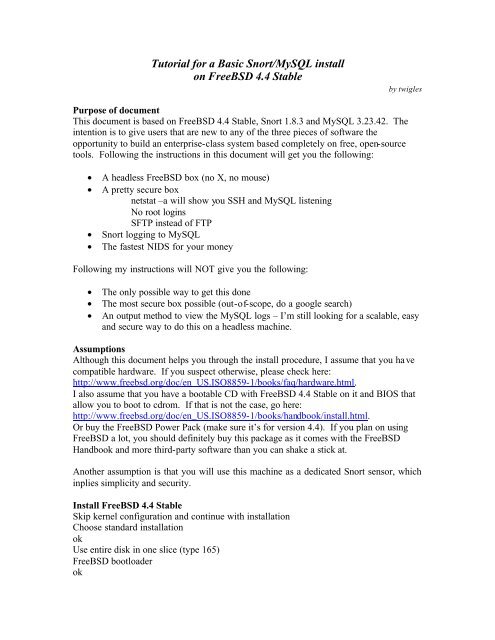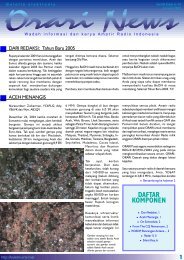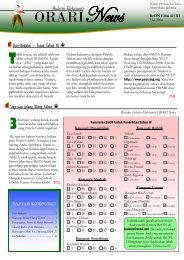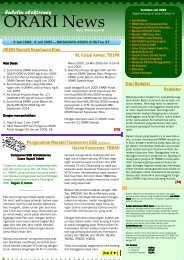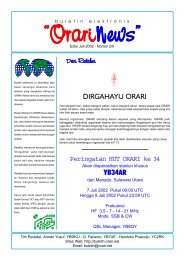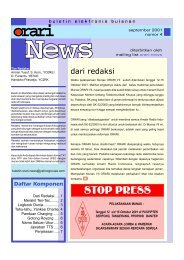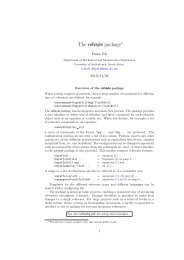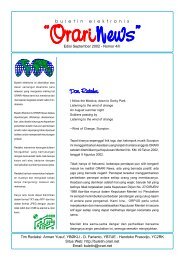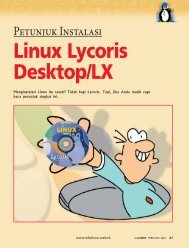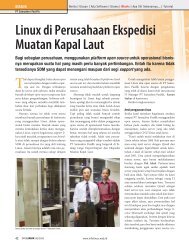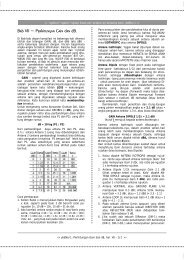Tutorial for a Basic Snort/MySQL install on FreeBSD ... - Kambing UI
Tutorial for a Basic Snort/MySQL install on FreeBSD ... - Kambing UI
Tutorial for a Basic Snort/MySQL install on FreeBSD ... - Kambing UI
You also want an ePaper? Increase the reach of your titles
YUMPU automatically turns print PDFs into web optimized ePapers that Google loves.
<str<strong>on</strong>g>Tutorial</str<strong>on</strong>g> <str<strong>on</strong>g>for</str<strong>on</strong>g> a <str<strong>on</strong>g>Basic</str<strong>on</strong>g> <str<strong>on</strong>g>Snort</str<strong>on</strong>g>/<str<strong>on</strong>g>MySQL</str<strong>on</strong>g> <str<strong>on</strong>g>install</str<strong>on</strong>g><br />
<strong>on</strong> <strong>FreeBSD</strong> 4.4 Stable<br />
by twigles<br />
Purpose of document<br />
This document is based <strong>on</strong> <strong>FreeBSD</strong> 4.4 Stable, <str<strong>on</strong>g>Snort</str<strong>on</strong>g> 1.8.3 and <str<strong>on</strong>g>MySQL</str<strong>on</strong>g> 3.23.42. The<br />
intenti<strong>on</strong> is to give users that are new to any of the three pieces of software the<br />
opportunity to build an enterprise-class system based completely <strong>on</strong> free, open-source<br />
tools. Following the instructi<strong>on</strong>s in this document will get you the following:<br />
• A headless <strong>FreeBSD</strong> box (no X, no mouse)<br />
• A pretty secure box<br />
netstat –a will show you SSH and <str<strong>on</strong>g>MySQL</str<strong>on</strong>g> listening<br />
No root logins<br />
SFTP instead of FTP<br />
• <str<strong>on</strong>g>Snort</str<strong>on</strong>g> logging to <str<strong>on</strong>g>MySQL</str<strong>on</strong>g><br />
• The fastest NIDS <str<strong>on</strong>g>for</str<strong>on</strong>g> your m<strong>on</strong>ey<br />
Following my instructi<strong>on</strong>s will NOT give you the following:<br />
• The <strong>on</strong>ly possible way to get this d<strong>on</strong>e<br />
• The most secure box possible (out-of-scope, do a google search)<br />
• An output method to view the <str<strong>on</strong>g>MySQL</str<strong>on</strong>g> logs – I’m still looking <str<strong>on</strong>g>for</str<strong>on</strong>g> a scalable, easy<br />
and secure way to do this <strong>on</strong> a headless machine.<br />
Assumpti<strong>on</strong>s<br />
Although this document helps you through the <str<strong>on</strong>g>install</str<strong>on</strong>g> procedure, I assume that you have<br />
compatible hardware. If you suspect otherwise, please check here:<br />
http://www.freebsd.org/doc/en_US.ISO8859-1/books/faq/hardware.html.<br />
I also assume that you have a bootable CD with <strong>FreeBSD</strong> 4.4 Stable <strong>on</strong> it and BIOS that<br />
allow you to boot to cdrom. If that is not the case, go here:<br />
http://www.freebsd.org/doc/en_US.ISO8859-1/books/handbook/<str<strong>on</strong>g>install</str<strong>on</strong>g>.html.<br />
Or buy the <strong>FreeBSD</strong> Power Pack (make sure it’s <str<strong>on</strong>g>for</str<strong>on</strong>g> versi<strong>on</strong> 4.4). If you plan <strong>on</strong> using<br />
<strong>FreeBSD</strong> a lot, you should definitely buy this package as it comes with the <strong>FreeBSD</strong><br />
Handbook and more third-party software than you can shake a stick at.<br />
Another assumpti<strong>on</strong> is that you will use this machine as a dedicated <str<strong>on</strong>g>Snort</str<strong>on</strong>g> sensor, which<br />
inplies simplicity and security.<br />
Install <strong>FreeBSD</strong> 4.4 Stable<br />
Skip kernel c<strong>on</strong>figurati<strong>on</strong> and c<strong>on</strong>tinue with <str<strong>on</strong>g>install</str<strong>on</strong>g>ati<strong>on</strong><br />
Choose standard <str<strong>on</strong>g>install</str<strong>on</strong>g>ati<strong>on</strong><br />
ok<br />
Use entire disk in <strong>on</strong>e slice (type 165)<br />
<strong>FreeBSD</strong> bootloader<br />
ok
This is my file system layout <strong>on</strong> a 9 Gigabyte hard drive.<br />
Size Mount Point<br />
300M /<br />
1000M swap<br />
400M /usr<br />
300M /tmp<br />
6746M /var<br />
Choose minimal <str<strong>on</strong>g>install</str<strong>on</strong>g><br />
Choose from CD or FTP...<br />
ok<br />
ok after c<strong>on</strong>gratulati<strong>on</strong>s<br />
Choose yes to c<strong>on</strong>figure ethernet card<br />
C<strong>on</strong>figure your ethernet card. For example my 3com card is fxp0<br />
Choose no to ip6<br />
Choose no to dhcp<br />
Enter your IP in<str<strong>on</strong>g>for</str<strong>on</strong>g>mati<strong>on</strong>, make sure you choose a correct name server <str<strong>on</strong>g>for</str<strong>on</strong>g> later<br />
Choose yes bring the interface up now<br />
Choose no as gateway<br />
Choose yes to inetd (all off by default) **See below**<br />
Choose yes to c<strong>on</strong>firm inetd<br />
Choose no to use current settings<br />
Choose no to an<strong>on</strong> ftp<br />
Choose no to nfs server<br />
Choose no to nfs client<br />
Choose no, use moderate security<br />
ok<br />
Choose no to customize c<strong>on</strong>sole settings<br />
Choose yes to set time z<strong>on</strong>e<br />
Choose no<br />
Choose your time z<strong>on</strong>e<br />
Yes to 'PST'<br />
Choose no to Linux compatibility<br />
Choose no to USB mouse<br />
Choose exit this menu, this is a headless stati<strong>on</strong><br />
Choose no, d<strong>on</strong>'t c<strong>on</strong>figure X<br />
Choose no, d<strong>on</strong>'t browse/<str<strong>on</strong>g>install</str<strong>on</strong>g> ports collecti<strong>on</strong><br />
Choose yes, add user account – this is who you will SSH into the box as initially<br />
Choose user - add new user to the system<br />
Login id is snort<br />
uid is 1001<br />
group is wheel<br />
password - snortman<br />
all else blank, ok<br />
exit this menu<br />
ok to set root passwd – snortman5000
Choose no, d<strong>on</strong>'t do any last minute opti<strong>on</strong>s<br />
exit <str<strong>on</strong>g>install</str<strong>on</strong>g><br />
Choose yes, you're sure, remove all bootable media<br />
That’s it!<br />
inetd<br />
**You can choose to <str<strong>on</strong>g>install</str<strong>on</strong>g> inetd if you want and simply turn everything off. This way if<br />
you need an FTP server <str<strong>on</strong>g>for</str<strong>on</strong>g> some reas<strong>on</strong> you can turn it <strong>on</strong> and then turn it off when<br />
you’re d<strong>on</strong>e. Pers<strong>on</strong>ally I do the base <str<strong>on</strong>g>install</str<strong>on</strong>g> from the c<strong>on</strong>sole and then SSH into the box<br />
from my Windows machine (nice graphics card, 21’ m<strong>on</strong>itor) using this client:<br />
http://www.ssh.com/products/ssh/download.cfm. This way I have multiple windows and<br />
the ability to scroll up and down. Please note that although this is a free download, there<br />
are license restricti<strong>on</strong>s. I AM NOT RESPONSIBLE FOR YOUR COMPLIANCE WITH<br />
SSH.COM’S LICENSE RESTRICTIONS. If you d<strong>on</strong>’t think you are eligible to use this<br />
client freely, buy it or use Putty.<br />
Your first boot<br />
On first boot BSD will generate SSH keys and sendmail will hang boot <str<strong>on</strong>g>for</str<strong>on</strong>g> about a<br />
minute<br />
mv /etc/motd /etc/motd.default<br />
vi motd, insert your warning banner (leave 2 empty lines at top, or they WILL be erased)<br />
edit /etc/rc.c<strong>on</strong>f, comment out sendmail and usbd (change to NO)<br />
If you <str<strong>on</strong>g>install</str<strong>on</strong>g>ed inetd, leave inetd.c<strong>on</strong>f al<strong>on</strong>e-everything is disabled by default. Or <str<strong>on</strong>g>for</str<strong>on</strong>g><br />
peace of mind, check it out yourself and make sure everything has a pound sign in fr<strong>on</strong>t<br />
of it.<br />
<str<strong>on</strong>g>MySQL</str<strong>on</strong>g> – Downloading the necessary packages<br />
Pers<strong>on</strong>ally I like to put all of the packages into /usr so I make sure I’m in /usr when I start<br />
my FTP sessi<strong>on</strong>.<br />
Goto ftp://ftp.freebsd.org/pub/<strong>FreeBSD</strong>/ports/i386/packages-4.4-release/<br />
Grab from databases:<br />
mysql-client-3.23.42.tgz<br />
mysql-server-3.23.42.tgz<br />
p5-DBI-1.19.tgz<br />
p5-Mysql-modules-1.2216.tgz<br />
Grab from devel:<br />
p5-Data-ShowTable-3.3<br />
<str<strong>on</strong>g>MySQL</str<strong>on</strong>g> – adding the packages<br />
Do the pkg_add in this order (other orders may work, but I know this <strong>on</strong>e does):<br />
pkg_add p5-DBI-1.19.tgz<br />
pkg_add p5-Data-ShowTable-3.3.tgz<br />
pkg_add mysql-client-3.23.42.tgz<br />
pkg_add p5-Mysql-modules-1.2216.tgz<br />
pkg_add mysql-server-3.23.42.tgz
The user and group "mysql" are added with the server package, and a startup script is<br />
automatically put in /usr/local/etc/rc.d. <str<strong>on</strong>g>MySQL</str<strong>on</strong>g> will now start <strong>on</strong> boot.<br />
Setting up basic <str<strong>on</strong>g>MySQL</str<strong>on</strong>g> functi<strong>on</strong>ality<br />
Run the following commands as root:<br />
/usr/local/bin/mysql_<str<strong>on</strong>g>install</str<strong>on</strong>g>_db<br />
/usr/local/etc/rc.d/mysql-server.sh start<br />
Do a “netstat –a”. It should show port 3306 listening.<br />
Do a “ps –aux”. It should show "/usr/local/libexec/mysqld --basedir=/usr/local -datadir=/var/db/mysql<br />
--user=mysql"<br />
Kill mysqld process – “/usr/local/etc/rc.d/mysql-server.sh stop”<br />
Change directory to /usr/local/share/mysql. Look through the four different .cnf files to<br />
see which <strong>on</strong>e matches your situati<strong>on</strong> best. Pers<strong>on</strong>ally I used “my-large.cnf” so I did the<br />
following:<br />
cp /usr/local/share/mysql/my-large.cnf /etc/my.cnf<br />
restart mysqld<br />
As root at shell type “/usr/local/bin/mysql”<br />
To change the root passwd to "snortman", at mysql prompt type:<br />
SET PASSWORD FOR root@localhost=PASSWORD('snortman');<br />
For the changes to take affect type<br />
FLUSH PRIVELEGES;<br />
quit<br />
* D<strong>on</strong>’t <str<strong>on</strong>g>for</str<strong>on</strong>g>get the semi-col<strong>on</strong> at the end of every command in <str<strong>on</strong>g>MySQL</str<strong>on</strong>g> except quit.<br />
Now type “/usr/local/bin/mysql”l and you should get rejected.<br />
Type “/usr/local/bin/mysql -p” and enter the password when prompted.<br />
Quit again, it's time to <str<strong>on</strong>g>install</str<strong>on</strong>g> <str<strong>on</strong>g>Snort</str<strong>on</strong>g><br />
Downloading and <str<strong>on</strong>g>install</str<strong>on</strong>g>ing <str<strong>on</strong>g>Snort</str<strong>on</strong>g><br />
Again, I happen to like having these things in /usr so that’s where I sit when I start my<br />
FTP sessi<strong>on</strong>. This is strictly preference.<br />
Libpcap<br />
download libpcap-0.6.2.tar.gz (www.tcpdump.org)<br />
gunzip libpcap-0.6.2.tar.gz<br />
tar -xf libpcap-0.6.2.tar<br />
ln -s libpcap-0.6.2 libpcap<br />
cd libpcap<br />
./c<strong>on</strong>figure<br />
make<br />
make <str<strong>on</strong>g>install</str<strong>on</strong>g>
<str<strong>on</strong>g>Snort</str<strong>on</strong>g><br />
download snort-1.8.3.tar.gz. There isn't an FTP site so get it somehow.<br />
gunzip snort-1.8.3.tar.gz<br />
tar -xf snort-1.8.3.tar<br />
ln -s snort-1.8.3 snort<br />
cd snort<br />
./c<strong>on</strong>figure --with-mysql=/usr/local/libexec<br />
make<br />
make <str<strong>on</strong>g>install</str<strong>on</strong>g><br />
Type "snort -v" to test if <str<strong>on</strong>g>Snort</str<strong>on</strong>g> is working. This starts snort in sniffer mode.<br />
Stop <str<strong>on</strong>g>Snort</str<strong>on</strong>g> with [cntl-c]<br />
*** Note that mysql is <strong>on</strong>ly in /usr/local/libexec because I used the <strong>FreeBSD</strong> package. If<br />
you <str<strong>on</strong>g>install</str<strong>on</strong>g> it from binary, it will be in a different place.<br />
Telling <str<strong>on</strong>g>Snort</str<strong>on</strong>g> to log to <str<strong>on</strong>g>MySQL</str<strong>on</strong>g><br />
vi /usr/snort/snort.c<strong>on</strong>f and edit it to reflect your network. I will not go into this here<br />
since it is covered in w<strong>on</strong>derful detail in the <str<strong>on</strong>g>Snort</str<strong>on</strong>g> User’s Manual. However I will tell<br />
you what to change to log to <str<strong>on</strong>g>MySQL</str<strong>on</strong>g>.<br />
In Secti<strong>on</strong> 3 change the following:<br />
Under the database secti<strong>on</strong> add or modify existing line to read:<br />
"output database: log, mysql, user=root password=snortman dbname=snort<br />
host=localhost"<br />
*** Note: If you edit the rules files in Notepad you MUST go into vi and remove the<br />
"^M"s<br />
Setting up <str<strong>on</strong>g>MySQL</str<strong>on</strong>g> to accept data from <str<strong>on</strong>g>Snort</str<strong>on</strong>g><br />
Set up the mysql database <str<strong>on</strong>g>for</str<strong>on</strong>g> snort with the included scripts:<br />
As root at shell type "echo "CREATE DATABASE snort;" | /usr/local/bin/mysql -u root -<br />
p"<br />
Log into mysql and type "grant INSERT,SELECT <strong>on</strong> snort.* to root@localhost;"<br />
Quit mysql<br />
Change directory to /usr/snort, then type "/usr/local/bin/mysql -p <<br />
./c<strong>on</strong>trib/create_mysql snort"<br />
Type “mkdir /var/log/snort”<br />
Log into mysql and verify your snort tables:<br />
mysql> use snort<br />
Database changed<br />
mysql> show tables;<br />
+------------------+<br />
| Tables_in_snort |<br />
+------------------+<br />
| data |
| detail |<br />
| encoding |<br />
| event |<br />
| icmphdr |<br />
| iphdr |<br />
| opt |<br />
| reference |<br />
| reference_system |<br />
| schema |<br />
| sensor |<br />
| sig_class |<br />
| sig_reference |<br />
| signature |<br />
| tcphdr |<br />
| udphdr |<br />
+------------------+<br />
16 rows in set (0.00 sec)<br />
mysql><br />
This is my snort startup script. Put this in /usr/local/etc/rc.d.<br />
D<strong>on</strong>'t <str<strong>on</strong>g>for</str<strong>on</strong>g>get to chmod 750 it.<br />
#!/bin/sh<br />
sleep 5<br />
case "$1" in<br />
start)<br />
if [ -x /usr/local/bin/snort ]; then<br />
/usr/local/bin/snort -c /usr/snort/snort.c<strong>on</strong>f -D > /dev/null & && echo -n '<br />
snort'<br />
fi<br />
;;<br />
stop)<br />
/usr/bin/killall snort > /dev/null 2>&1 && echo -n ' snort'<br />
;;<br />
*)<br />
echo ""<br />
echo "Usage: `basename $0` { start | stop }"<br />
echo ""<br />
exit 64<br />
;;<br />
esac
Reboot your box<br />
As root type “shutdown -r now” or “reboot”


